Review and prospect of the effectsof freeze-thaw on soil geotechnical properties
Tong Zhang ,HaiPeng Li*,ChenChen Hu ,XinYu Zhen ,ZhenHao Xu ,Yang Xue
1.State Key Laboratory for Geomechanics and Deep Underground Engineering,China University of Mining and Technology,Xuzhou,Jiangsu 221116,China
2.School of Mechanics and Civil Engineering,China University of Mining Science and Technology,Xuzhou,Jiangsu 221116,China
ABSTRACT Freeze-thaw hazard is one of the main problems in cold regions engineering and artificial ground freezing engineering.To mitigate freeze-thaw hazards,it is essential to investigate the effects of freeze-thaw on soils engineering properties.This paper summarizes the effects of freeze-thaw on the physical and mechanical properties of soils reported in recent studies.The differences of freeze-thaw conditions between freezing shaft sinking and cold regions engineering are discussed.Based on the technological characteristics of freezing shaft sinking in deep alluvium,we further attempt to identify key research needs regarding the freeze-thaw effects on the engineering properties of deep soils.
Keywords:freeze-thaw effects;soil physical and mechanical properties;deep clay;freezing shaft sinking
1 Introduction
The permafrost distribution area accounts for about 75%of the total land area in China.Therefore,infrastructure constructions in the broad cold regions,including permafrost and seasonally frozen regions,play an important role in China's economic and social development.The soils in cold regions experience freeze-thaw cycling due to the temperature changes periodically,which can cause uplift,subsidence,and cracking of subgrade,slope instability,building foun‐dation damage,oil pipeline fracture,and other engi‐neering diseases (Cheng,2003).These diseases caused by freeze-thaw are among the main engineer‐ing challenges in cold regions.
Rich resources are buried under the deep alluvium in the central and eastern regions of China.Artificial ground freezing has been extensively applied in con‐structing vertical shafts to pass through the alluvium for resources extraction.This method is commonly re‐ferred to as freezing shaft sinking,which involves the following steps:1)drilling holes around the shaft;2)installing freezing pipes in the holes;3)circulating low-temperature brine in the freezing pipes to freeze the rock and soil around the shaft to form a frozen wall;and 4)excavate and construct the shaft linings under the protection of the frozen wall.After the com‐pletion of the shaft,the frozen wall is allowed to thaw.The thaw settlement of artificial frozen soils sig‐nificantly impacts the shaft linings in deep alluvium.For example,the shaft linings in Guotun coal mine(586-m topsoil and 702-m of frozen depth)suffered settlement-induced damage during the frozen soil wall thaw,including buckling of the water supply and drainage pipes on the shaft,seriously threatened the mine's operations(Luet al.,2013).
In the cold regions engineering and freeze shaft sinking applications,the soils experience one or more freeze-thaw cycles.The mechanical properties of soils can be significantly weakened owing to the freeze-thaw effects on soil structure,which is the fundamental reason for freeze-thaw diseases.
To control freeze-thaw diseases,extensive atten‐tion has been paid to the influences and mechanism of freeze-thaw on soil engineering properties.In this pa‐per,the research works about the freeze-thaw effects on physical properties,strength,consolidation defor‐mation,and soil microstructure are summarized,and the research needs regarding freeze-thaw effects on deep soils are prospected.
2 Soil physical properties
Since Chamberlainet al.(1979)carried out a se‐ries of uniaxial,cyclic and open system freeze-thaw tests on normally consolidated soft clay samples at low stress,researchers conducted a number of studies on the effects of freeze-thaw on the physical proper‐ties of soils,such as grain size distribution,Atterberg limits and dry bulk density.
2.1 Grain size distribution
The effect of freeze-thaw on the distribution of soil particles'sizes depends on the number of freeze-thaw and sensitive particles in the soils.Lehrsch(1998)found that the stability of soil aggregates increases with the increase of freeze-thaw cycles,and the stabil‐ity of aggregates is the highest when freeze-thaw cy‐cles are 2−3 times.It is also found that freeze-thaw cycles stabilized aggregates more at 0 to 15 mm than at 15 to 30 mm.Hanssonet al.(2006)found that with the soil particles becoming smaller,especially with the increase of clay content,the greater the effect of freeze-thaw is,rendering the soil more prone to frost heaving.Wanget al.(2012)studied the freeze-thaw effect on soil aggregate and found that most aggregate size classes were affected significantly(Particle size<0.05 mm)except for wet-sieved aggregates(Parti‐cle size>5 mm).Dry-sieved aggregates were rela‐tively more sensitive to the freeze-thaw treatment than wet-sieved aggregates.However,for compound soils of Pisha sandstone,sand and organic matter,the content of small soil aggregates(<0.5 mm)increased,while the content of large soil aggregates(>1.0 mm)decreased with the increase of freeze-thaw cycles(Zhanget al.,2016).
The freeze-thaw cycle promotes the change of mineral particles and changes soil particle size compo‐sition(Figure 1).The coarse particles(>0.1 mm)were broken first during freeze-thaw cycles,and the parti‐cles of 0.05−0.1 mm and 0.005−0.05 mm were bro‐ken after 5−7 freeze-thaw cycles(Zhanget al.,2015).Özganet al.(2015)found that the particles finer than 0.075 mm were more susceptible to freeze-thaw,and the curvature and uniformity coefficient of particles after freeze-thaw were almost the same.
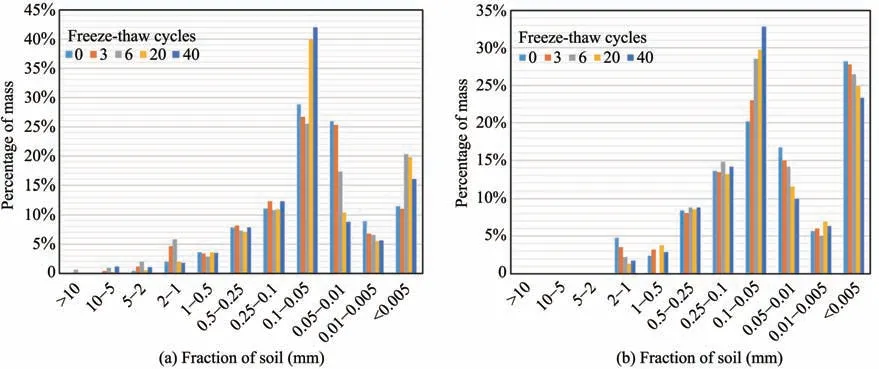
Figure 1 Effect of freezing thawing on grain size distribution(Zhang et al.,2015)
2.2 Atterberg limits
The Atterberg limits are important physical prop‐erties of fine-grained soils,reflecting how the soil geotechnical properties vary with water content.Yanget al.(2001,2002)conducted freeze-thaw tests on un‐disturbed and remolded soils and found that the plas‐tic limit is almost unchanged for the soils after freeze and thaw,but the liquid limit declines.Zhaet al.(2008)also studied the freeze-thaw effects on soils,and their results show that the liquid and plastic limits increase,but the liquidity index decreases.It is recog‐nized that freeze-thaw action causes the disintegration of soil aggregates,which impact soil water potential,hence the liquid and plastic limits.
Zhenget al.(2015)measured the Atterberg limit of Qinghai Tibet silty clay under different freeze-thaw cycles,and also found that with the increase of freeze-thaw cycles,the liquid limit and plastic limit will gradually increase,but the change rate will gradually decrease,whose results are contrary to those of Yanget al.(Figure 2).The reason may be due to the difference in the physical properties of the soil.

Figure 2 The variations of liquid limit and plastic limit of silty clay after a freeze-thaw cycle(Yang et al.,2002;Zheng et al.,2015)
2.3 Dry bulk density and void ratio
Soil bulk density and porosity are important physi‐cal parameters of soils.And the effect of freeze and thaw on soil density or void ratio depends on the ini‐tial dry bulk densities.The density of the soils with larger initial dry bulk density decreases,whereas that of soils with smaller initial dry bulk density increases after freeze-thaw action,resulting in compaction of loose soils(Yanget al.,2003).Additionally,Liuet al.(2009)found that the variations of soil bulk density and porosity are more significant for the soils with larger initial water content
Based on the investigations on fine-grained nonplastic till exposed to freeze-thaw cycles,Vikland‐er(1998)proposed the concept of residual void ratio;the void ratio of loose soil and dense soil tends to a stable state after multiple freeze-thaw cycles.Qiet al.(2005)summarized the research results and found that the density and permeability tend to be stable after 3−5 freeze-thaw cycles.It is also found that for loess,with the increase of freeze-thaw times,the porosity first de‐creases,then increases,and then tends to be stable(Xiaoet al.,2014).
3 Soil mechanical properties
3.1 Strength and elastic modulus
Large amount of experimental results show that freeze-thaw will reduce the mechanical performance of soils,such as compressive strength,elastic modu‐lus,cohesion and internal friction angle.Especially for the effect of freeze-thaw on soil strength,the con‐sensus,shown in Figure 3,is that freeze-thaw will re‐duce the shear strength of soil.
Wanget al.(2007)prepared remolded Qinghai clay samples,and carried out freeze-thaw and triaxi‐al compression tests to explore strength characteris‐tics.Their results show that the cohesion of soil de‐creases,and the internal friction angle increases after freeze-thaw.Buet al.(2015)found that the increase of fine particles will weaken the shear strength of coarse-grained soils when undergoing freeze-thaw.Water content and dry density also have a great influ‐ence on the shear modulus of frozen-thawed silt.With the decrease of water content and increase of dry den‐sity,the shear modulus increases(Zhanget al.,2017).Huet al.(2017a,b)reported that under different com‐paction degrees,the internal friction angle shows an increasing trend,the shear strength of clay signifi‐cantly decreases after freeze-thaw cycles and tends to be stable after five cycles.The freezing tempera‐ture and soil compactness in the freeze-thaw test will also affect the strength test results.In addition,the freeze-thaw cycles considerably affect the cohe‐sion,with the critical value of freeze-thaw cycles be‐ing about 5.However,the internal friction angle is not obviously influenced by freeze-thaw cycling(Xuet al.,2018).
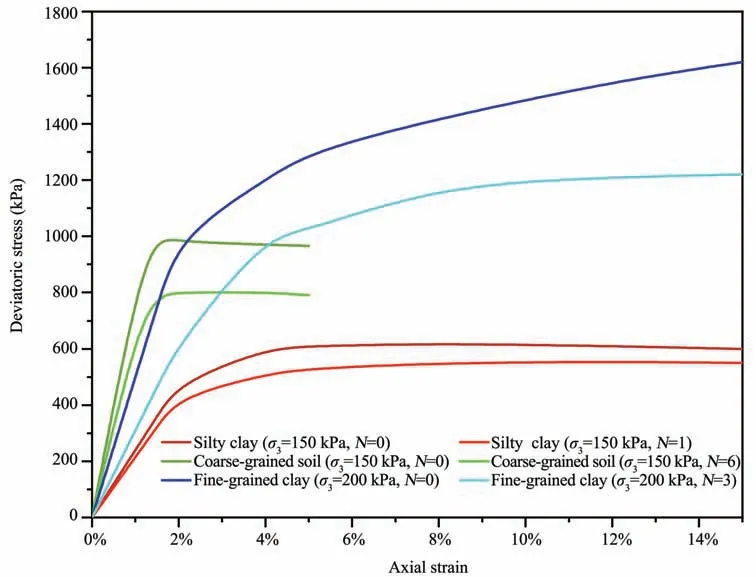
Figure 3 Effect of freezing thawing on shear strength of various soil samples under low stress(Wang et al.,2007;Bu et al.,2015;Hu et al.,2017)
Simonsenet al.(2002)tested the variation of elas‐tic modulus of coarse-grained and fine-grained soils with the freeze-thaw cycles.The results show that af‐ter a freeze-thaw cycle,the elastic modulus decreases by about 20%−60%for different soil types.The elas‐tic modulus is not only affected by soil types but also by stress conditions and freeze-thaw cycles.Some tests show that the elastic modulus of the same soil in‐creases with the increase of confining pressure under the same freeze-thaw cycles;the elastic modulus de‐creases with the increase of freeze-thaw cycles under the same confining pressure(Wanget al.,2012).Wanget al.(2010)also studied the freeze-thaw effect on soil resilient modulus.Their results show that soil resilient modulus decreases with the increase of freeze-thaw cycles and reaches a stable state after the sixth freeze-thaw cycle.
3.2 Compressibility and pore water pressure
Generally,the effect of freeze-thaw on soil com‐pressibility is related to soil properties,consolidation state,and freezing modes.
Eigenbrodet al.(1996)observed the change of com‐pression deformation of overconsolidated fine-grained soil during the freeze-thaw process and suggested that the freeze-thaw process causes the consolidation of soil.But for hard clay,if its initial water content is close to its plastic limit,the water content will not de‐crease during the freeze-thaw,and consolidation will not occur.
Yanget al.(2001)found that after freeze-thaw,the compressibility of clay decreases,and that of sand increases.Freeze and thaw have two different effects for remolded clay with different dry densities,includ‐ing reduced compressibility in low-density soils,and enhanced compressibility of high-density soil(Wanget al.,2009).The expansive soil with lower water con‐tent shows freeze shrinkage and thaw expansion,while expansive soil with higher water content shows freeze swelling and thaw contraction(Xuet al.,2016).There is a linear relationship between the ini‐tial void ratio and compressibility.The greater the ini‐tial void ratio is,the greater the compressibility is.With the increase of freeze-thaw cycles,soil com‐pressibility increases,but the growth gradually dimin‐ishes(Cheng and Wang,2019).Fanet al.(2019)pointed out that the freeze-thaw process triggers the re-consolidation in clay;the soil in the open system will produce a large settlement with the increase of the overburden,and the consolidation coefficient has a great influence on the soil compressibility.
The pore water pressure is a significant parameter for soil consolidation,but there are technical challeng‐es to measure the soil pore water pressure during freeze-thaw.Liuet al.(2012)proposed a method to measure the pore water pressure in high-temperature frozen soil in cold regions.Zhanget al.(2014)tested the pore water pressure changes of sand during the freeze and thaw process.Their results show that the pore water pressure of high water content samples first decreases and then slightly increases with the rise of temperature;the pore water pressure of the sample with lower water content is not sensitive to tempera‐ture.Xiaoet al.(2017)found that the pore water pres‐sure and water content first increase and then de‐crease during freezing,and the pore water pressure and water content first decrease and then increase during thawing.
4 Soil microstructure
The variations of soil mechanical properties re‐sult from the evolutions of soil microstructure by freeze-thaw.In the process of freezing and thawing,the reaction of water migration,phase change,and ice crystal growth on soil particles and pores is the fundamental reason for the destruction of soil struc‐ture(Zhenget al.,2015).
Niet al.(2014)found that after multiple freeze-thaw cycles,the structure of loess becomes looser,the original,inherent cementation between loess particles is gradually weakened.The original macrospores in the soil reduce,the small pores in‐crease,and the pore ratio also increases.Cuiet al.(2014)compared microscopic parameters of silty clay by SEM before and after freeze-thaw.Their results show that after freeze-thaw,the soils become loose,and the equivalent diameter decreases;the distribu‐tion of pore orientation angle before freeze-thaw has strong directionality,but it decreases to a certain ex‐tent after freeze-thaw.Xuet al.(2016)found that the porosity and pore orientation of expansive soils gradu‐ally increase and then tend to become stable during freeze-thaw cycling,and the first freeze-thaw cycle has the most significant impact on soil microstructure.
CT scanning has advantages in quantitatively and non-destructively revealing the internal changes of soils caused by freeze-thaw action.According to the results of CT scanning to unsaturated clay samples,the uneven volume shrinkage of samples is observed after freeze-thaw(Wanget al.,2017).The most signif‐icant change of macropore sizes occurs in the unfro‐zen zone near the final freezing front under water sup‐ply.More horizontal fissures are formed near unfro‐zen zone or freezing front,which depends on water supply conditions.The change of macropore structure is helpful to understand the influence of water soil in‐teraction on soil engineering properties,such as hy‐draulic permeability and compressibility(Fanet al.,2021).
5 Discussions
The research results show that the physical and mechanical properties of the soils,especially fine-grained soils,will be altered after freeze-thaw cy‐cles.However,most of the previous research focused on shallow stratum,and the depths of soils were no more than 100 m below the ground surface.For freez‐ing shaft sinking in deep alluvium,there is a lack of investigating the effect of freeze-thaw on the deep soils now.
Deep soils undergo sedimentation for a long geo‐logic time,the engineering properties of which are ob‐viously different from shallow soils.The deep clay,shown in Figure 4,has compact structure and low wa‐ter content.The void ratio of clay buried more than 100 m is generally less than 0.8,and decreases with the increasing of depth.Deep clay has high liquid plastic limit,and the maximum value of liquid index is not more than 0.25,and decreases with the increase of depth,which is generally less than 0 when the depth is more than 100 m.
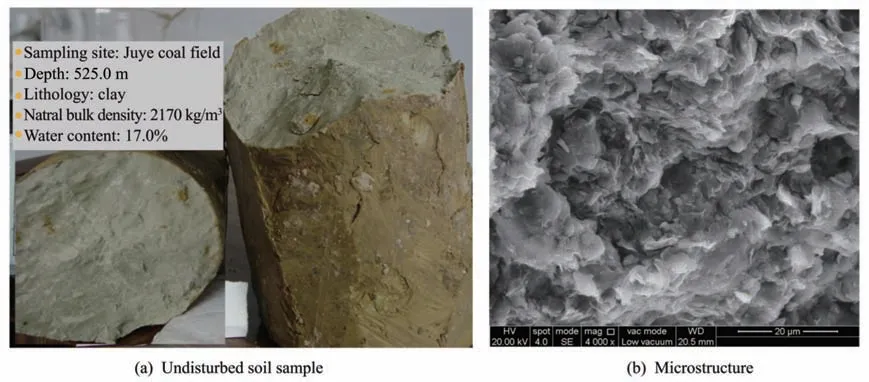
Figure 4 The geological features of deep clay
In freezing shaft sinking engineering,the deep soils are subjected to one time of freezing and thaw‐ing under high-stress conditions,and the stress value is 1−2 orders of magnitude larger than that of shallow soils.The field measurement results show that the ini‐tial horizontal ground pressure of stratum in 180−550 m depth varies from 1.21 MPa to 6.13 MPa.
It is different in the directions of heat flux and the maximum principal stress between naturally fro‐zen soils and artificially frozen soils in deep stratum.As is shown in Figure 1,for naturally frozen soils,the direction of heat flux is consistent with the direc‐tion of the maximum principal stress.In contrast,the heat flux direction is perpendicular to the direc‐tion of maximum principal stress in the freeze-thaw process.
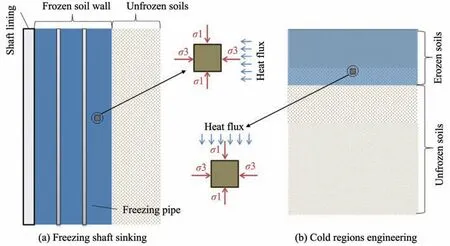
Figure 5 Sketch for heat-stress boundary conditions of shallow and deep soils in frozen ground engineering
Water transportation and ice formation are gov‐erned by the conditions of heat and stress(Wang,1993;Wanget al.,1995;Chenget al.,2014).Due to the difference in stress environment and thermal con‐ditions during freeze-thaw,the microstructure and physical properties of deep artificial frozen soils in freezing shaft sinking are different from that of shal‐low natural frozen soils in cold regions engineering,which will inevitably lead to different mechanical properties between deep soils and shallow soils.
Few studies investigated the shaft lining subjected to thaw consolidation of deep artificially frozen soils after freezing shaft sinking.In particular,for the deep clay with complicated engineering properties,the con‐solidation deformation of thawed clay under high overburden pressure lasts for a long time,which has an important impact on the shaft stability.Under the special thermal and mechanical conditions in freezing shaft sinking,the knowledge of the engineering prop‐erties of deep soils is lacking,such as the effect of freeze-thaw on the microstructure and physical prop‐erties of deep soils by under high earth pressure,the strength,rheology and consolidation properties of deep thawed soils.
Laboratory tests are an important means to study the effect of freeze-thaw on the physical and mechani‐cal properties of deep soils.At present,the conven‐tional laboratory test methods are not completely suit‐able for deep soils.It is imperative to develop key testing techniques,including preparation of deep re‐molded soil samples,measurement of pore water pres‐sure and unfrozen water content at high pressure,and reduction methods for the friction between soils and sidewall of odometer at high pressure.
6 Conclusions and prospect
(1)Extensive research results have been achieved about the effect of freeze-thaw on the geotechnical properties of naturally frozen soils in shallow strata.The physical and mechanical properties of soils are changed due to freeze-thaw cycles,such as the parti‐cle distribution,pores,bulk density,water content,strength,modulus of deformation.It is also found that there is a critical value for the relevant physical prop‐erties.Beyond a critical value,some physical parame‐ters of the soil will no longer be affected by freezing and thawing.
(2)The depth of alluvium has attained 755 m in freezing shaft sinking now.The geotechnical proper‐ties of deep soils and freeze-thaw conditions are sig‐nificantly different from that of shallow soils.It is necessary to systematically study the effects of freeze-thaw at high pressure on the physical proper‐ties,strength,rheology,consolidation,and microstruc‐ture of deep soils.
(3)To reflect deposition environments of deep soil strata,the freeze-thaw tests of deep soils should be conducted according to thermal-mechanical condi‐tions of freezing shaft sinking in deep alluvium.It is required to develop freeze-thaw experimental meth‐ods and technologies of frozen deep soils,which are valuable to freezing shaft sinking applied in ultradeep alluvium.
Acknowledgments:
This research was supported by the National Natural Science Foundation of China(Grant No.41771072);Jiangsu Province Innovation and Entrepreneurship Training program for University Students(Grant No.202010290171H).
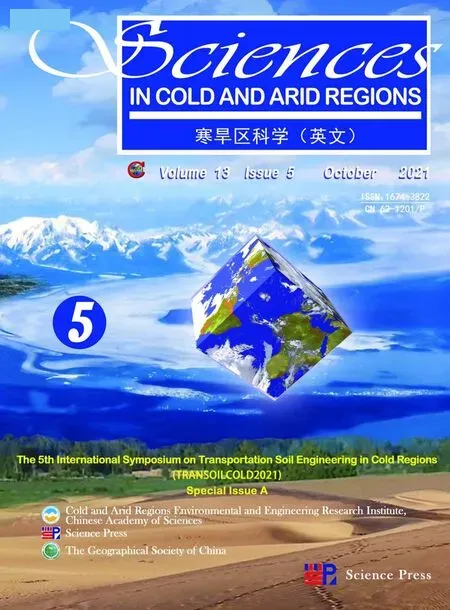 Sciences in Cold and Arid Regions2021年5期
Sciences in Cold and Arid Regions2021年5期
- Sciences in Cold and Arid Regions的其它文章
- Stabilizing subgradesof transport structures by injecting solidifying solutionsin cold regions
- Rationale for creation of capillary breaking layersin cold regions subgrade by pressure injection of waterproofing compounds
- Lessonsfrom construction and health condition evaluation of high-grade highway in permafrost regions
- Study on tensile damage characteristicsof sandstone under freeze-thaw cycles
- Numerical simulation of electroosmosis in unsaturated compacted clay
- Field monitoring of differential frost heave in widened highway subgrade
